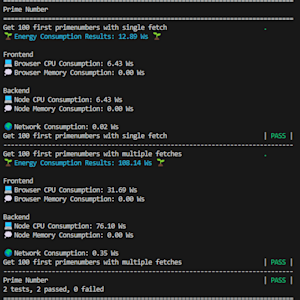
I've been working with a client over the past year, and one persistent issue has been the lack of a decent test reporting solution. After some digging, I stumbled upon robotframework-dashboard, which seemed to tick all the boxes I needed for extracting meaningful test run statistics.
My starting point; I run tests across three environments — dev, uat, and staging — using both Firefox and Chromium. To generate useful historical data, I needed to:
Store `output.xml` files for post-processing
Retain the resulting database after processing
Have a backend to serve reports
As GitHub offeres “github-pages”, eg a service where one can host static html’s, my needed list of functionality boils down to how and at what stage i would process output.xml and where to store the resulting database?
Since robotframework-dashboard supports sqlite as its backend, storing that database within repository ain’t an bad option. At least not until the size of the sqlite file gets big enough but for now, storing it in git is good “poc” solution.
At this point as I already had my initial test workflow collecting all the necessary information my intial thought would be to make a separate workflow that gets triggered after actual testruns. One gotcha here thought. As explained earlier, 6 test runs in total nightly so I needed 6 different sqlite files and the newly created workflow had to know the parameters that where used to trigger the test run so that output.xml could be processed correctly.
I solved this by generating a new file that i will store along the output.xml as build artifact:
- name: Install Dependencies & Generate env data run: | # irrelevant stuff removed mkdir -p reports echo export BROWSER=${{ inputs.DEFAULT_BROWSER }} > reports/env.sh echo export ENVIRONMENT=${{ inputs.TEST_ENV }} >> reports/env.sh
In this part, I’m storing the 2 arguments from workflow into separate shell script.
And then store the needed files as artifacts that could be later processed.
- name: COLLECT - Dashboard data uses: actions/upload-artifact@v4 with: name: dashboarddata path: | reports/output.xml reports/env.sh
Both of these steps are part of the actual testrun workflow and are run in the same job as the tests. The next step is to create a new workflow that will be triggered after the testrun workflow has completed. This workflow will process the output.xml and generate and/or update the existing sqlite database.
name: Generate Dashboard on: workflow_run: workflows: ["Nightly / DEV / Chromium", "Nightly / DEV / Firefox", "Nightly / Staging / Chromium", "Nightly / Staging / Firefox", "Nightly / UAT / Chromium", "Nightly / UAT / Firefox"] types: - completed
This takes care of triggering. On workflows:, I listed all the jobs in my repository that will trigger this dashboard generation workflow.
In order to access all required features i needed during dashboard generation workflow, following permissions and settings need to be setup at the start of the workflow:
jobs: process-artifact: environment: name: github-pages url: ${{ steps.deployment.outputs.page_url }} runs-on: ubuntu-latest permissions: contents: write id-token: write pages: write actions: read
Environment is set to github-pages and url is provided from github. URL will depend on repository access like is it on enterprise or public github but essentially its provided automatically. First 3 permissions are important as those allows the workflow to write to the repository and update the github-pages branch. actions: read is needed to access the artifacts if repository is private.
Next step is to setup the workflow with actions dealing with pages:
steps: - name: Setup Pages uses: actions/configure-pages@v5 - name: Checkout code uses: actions/checkout@v4 with: fetch-depth: 0 # Fetch all history for all branches and tags ref: "refs/heads/dashboard" - name: Set up Python 3.12 uses: actions/setup-python@v5 with: python-version: "3.12" - name: Install Dependencies run: | python -m pip install --upgrade pip setuptools wheel python -m pip install robotframework-dashboard
So, actions/configure-pages is the first step and should be self explanatory if you have dealt with github-pages before and then make sure there’s working python and all the tools needed to process the output.xml and generate the sqlite database and pages. In this case, robotframework-dashboard is the only dependency needed.
But what about actions/checkout ? Im pulling in a branch from the same repository with fetch-depth set to 0. Why? I want to store my sqlite db files in that branch so that I don’t need deal with persistency of data or handling of actual dev/production branches getting random commits from dashboard generation.
This dashboard branch was generated by creating “orphan” branch in the repository:
git checkout --orphan dashboard
This creates a new branch with no history and no files. On this branch i added a single html (site/index.html) that has combobox that will show 1 of the 6 generated html files from robotframework-dashboard within iframe and 6 empty sqlite database files.
Next step in workflow is to get the data:
- name: Download artifact from triggering workflow uses: actions/download-artifact@v4 with: name: dashboarddata path: output/ run-id: $\{\{ github.event.workflow_run.id \}\} github-token: $\{\{ secrets.GITHUB_TOKEN \}\}
On this stage, passing run-id as that gives a correct “upstream” workflow id where we are downloading dashboarddata artifact from. The path is where the artifact will be downloaded to and github-token is needed to access the artifacts if the repository is private. And now we have both, output.xml and env.sh available for processing.
- name: Generate Dashboard run: | source ./output/env.sh robotdashboard \ -o output/output.xml \ -d ./db/${ENVIRONMENT}_${BROWSER}.db \ -g False
for db in db/*.db; do x=$(basename "$db" .db) robotdashboard \ -d ${db} \ -t "Nightly on ${x}" \ -g True \ -n site/${x}.html done
And here is where the magic happens. First we source the generated env.sh so that we have BROWSER and ENVIRONMENT env variables set. On initial call to robotdashboard, we are importing the data from output.xml into correct sqlite database and omit html generation. This is important because everytime this workflow is called, I need to generate all 6 html files so that deployment wont remove existing files. And thus, second call to robotdashboard is where we generate all those html files.
Next step, since we modified the sqlite database - we need to store that so that consecutive runs will always have previous data available.
- name: Commit and push changes run: | source ./output/env.sh git config user.name "github-actions[bot]" git config user.email "github-actions[bot]@users.noreply.github.com" git add ./db/${ENVIRONMENT}_${BROWSER}.db git diff --cached --quiet || git commit -m "Processed artifact and updated files" git push origin HEAD:dashboard
And once again, we source the env.sh so that we know what database should have been modified. Rest of the steps are pretty standard git commands. We add the modified sqlite database and commit it. If there are no changes, we skip the commit step.
And finally, we need to deploy the generated html files to github-pages:
- name: Upload artifact uses: actions/upload-pages-artifact@v3 with: # Upload entire repository path: site - name: Deploy to GitHub Pages id: deployment uses: actions/deploy-pages@v4
actions/upload-pages-artifacts gets path: set to site/, where all 6 newly created/updated dashboard files are along with the initial index.html that acts as selector for the 6 dashboards. And then we use actions/deploy-pages to deploy the site to github-pages















